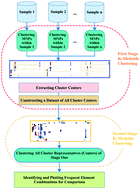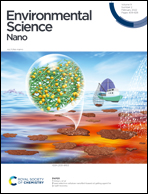Identification and quantification of anthropogenic nanomaterials in urban rain and runoff using single particle-inductively coupled plasma-time of flight-mass spectrometry†
Abstract
Urban rain and runoff are potential sources of anthropogenic nanomaterials (engineered and incidental, ENMs and INMs) to receiving waterbodies. However, there is currently a limited knowledge on the nature and concentration of anthropogenic NMs in urban rain and runoff and the current study aims to fill this knowledge gap. Runoff samples were collected from drainage outlets of two bridges (Quail Lane and Blossom Street) in Columbia, South Carolina, representing small and medium size bridges at different times over the duration of precipitation events. Rain samples were collected in the vicinity of the same bridges at the same time as the runoff. Two soil samples at depths of 0 to 3 and 3 to 15 cm were collected at each runoff sampling site to extract background natural NMs. The elemental composition of NMs in the rain, runoff, and soils were determined using single particle-inductively coupled plasma-time of flight-mass spectroscopy (SP-ICP-TOF-MS). Nanomaterials were sorted into groups of similar elemental composition and compared among samples using a two-stage agglomerative hierarchical clustering. Several classes of anthropogenic NMs were identified in the urban rain and runoff, including iron, vanadium, titanium, barium, zinc, copper, chromium, tungsten, antimony, tin, and lead-bearing NMs, most likely due to traffic-related emissions. The total concentrations of anthropogenic titanium and tungsten were estimated using mass balance calculations, total Ti and W concentrations, and shifts in the elemental ratios of Ti/Nb and W/U above the natural background ratios. The concentrations of anthropogenic Ti- and W- in Blossom Street and Quail Lane bridges runoff ranged from 6.0 ± 2.1 to 60.6 ± 0.8 μg Ti L−1 and 1.9 ± 0.7 to 20.2 ± 1.8 μg Ti L−1, and 0.23 ± 0.02 to 0.66 ± 0.03 μg W L−1, and 0.11 ± 0.01 to 0.38 ± 0.03 μg W L−1, respectively. Additionally, anthropogenic Ti and W concentrations generally decreased with time following the start of the storm events and increased with increases in traffic density. The detection of anthropogenic NMs in rain implies their occurrence in the atmosphere and thus a potential human exposure/risk via inhalation. The direct discharge of anthropogenic NMs to surface water with urban runoff implies exposure and potential risks to aquatic organisms.

- This article is part of the themed collection: Nanomaterials in air


 Please wait while we load your content...
Please wait while we load your content...
